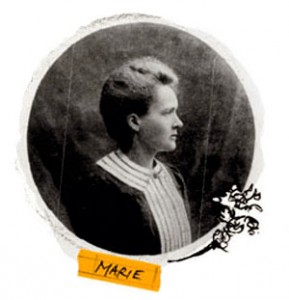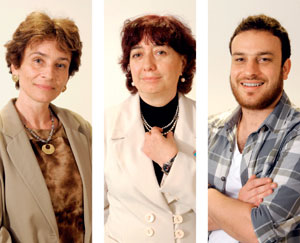
ILLUSTRATION PAULA GABBAI; PHOTO JAMES STOKLEYMarie Curie in the photo published in the Nobel Prize in 1903ILLUSTRATION PAULA GABBAI; PHOTO JAMES STOKLEY
Marie Curie, who was born in Poland and settled in France, was the first woman to win a Nobel Prize and so far the only woman to win in two categories. The first, in 1903, was awarded in a partnership with her husband, Pierre Curie, and with Antoine Henri Becquerel, for their studies on radioactivity. But it was her second Nobel Prize that merited celebrations as the central focus of the International Year of Chemistry in 2011. A century earlier, Madame Curie won the Chemistry Prize on her own for her discovery of radium and polonium, two radioactive elements. Given this tribute, there was nothing more appropriate than to deal with her and the women of science on the last day of the cycle organized by FAPESP and the Brazilian Chemical Society and divulged by Pesquisa FAPESP every month since May.
“The contribution of women to science is one third”, stated coordinator Marília Goulart, from the Federal University of Alagoas. “What will it be 10 years from now?” For her, science requires passion and is not a question of gender. However, policies are needed that favor the balance between scientist and mother, a division of roles that still causes women difficulties in a career that demands absolute dedication. The talks were given on November 9 and speakers included chemist Maria Vargas, from Fluminense Federal University (UFF), science historian Ana Maria Alfonso-Goldfarb, from the Pontifical Catholic University of São Paulo (PUC-SP), and social scientist Gabriel Pugliese, from the School of Sociology and Politics of São Paulo; this was a panel that was two thirds female, inverting the predominance of men in science.
Few illustrious women
The overview of the role of women scientists promised in her title by Maria Vargas began right there, within the auditorium: Vanderlan Bolzani, a professor from Paulista State University (Unesp) in Araraquara and one of the organizers of the cycle of conferences at FAPESP, was the first woman to preside over the Brazilian Chemical Society, between 2008 and 2010. However, going back in time, the researcher from UFF insisted on highlighting Clara Immerwahr, who in 1890 put studies before a marriage proposal she received from chemist Fritz Haber, who was known for his synthesis of ammonia. She studied chemistry only as a spectator at university and in 1900 was the first woman in Germany to get a doctorate. In the following year, however, she accepted marriage and perhaps without knowing it, signed the end of her scientific career. Despite working with her husband, Clara’s name was never cited. The marriage also represented the end of her own life to a certain extent: she opposed her husband and the country for the production of chemical weapons in the First World War, which she considered to be a “perversion of science”. In protest against the role of Haber in supervising the first gas attack in military history, and accused by her husband of being a traitor to the fatherland, she committed suicide in 1915, aged 45. So a woman who could have contributed to science ended up entering history because of her courage in manifesting her pacifist conviction without giving in to family and social pressures.
In the history of the Nobel Prize, 40 women have so far won: only 4 in chemistry. The first was Marie Curie, in 1911. Married to physicist Pierre Curie since 1895, the two did part of the work in collaboration and together discovered that pitchblende, a mineral discovered by Becquerel, was rich in polonium and radium, two elements that are more radioactive than uranium. Dedication to the life of science, which she managed to reconcile with her family life, also cost Marie dear. In 1934, she died of leukemia, like many people who worked with the chemistry of radioactivity before the harmful effects of these substances were known.
Then it was the turn of her daughter, Irène, to win the Nobel Prize , which she shared with her husband (and former PhD student of Marie Curie), Frédéric Joliot in 1935. After Pierre and Marie Curie had distinguished themselves with their studies on natural radioactivity, her daughter achieved the maximum prize in science by revealing artificial radioactivity, in which elements that do not behave like this are induced to become radioactive. Irène, like her mother, was never elected to the French Academy of Sciences – their respective husbands were.
Another scientist that Maria Vargas highlighted was a British woman born in Egypt, Dorothy Crowfoot Hodgkin, who fell in love with chemistry when she did an experiment for growing copper sulfate crystals at school. She developed her passion, with the full support of her parents, who allowed her to assemble a laboratory in the attic of their house. In 1945, through her studies of crystallography, she determined the chemical structure of penicillin, which had been discovered by Alexander Fleming 16 years earlier. To transform the fungus into an antibiotic drug, which later came to save millions of lives, it was necessary to synthesize the active substance in a laboratory. At the age of 47 and the mother of three children, the discovery led to her becoming a member of the Royal Society, the British science academy.
Married to Thomas Hodgkin, a leftwing idealist, she managed to gain recognition as a researcher and mother: hers was the first paid maternity leave at Oxford University. Dorothy also determined the structure of vitamin B12, work that led to various medical applications and earned her the Nobel Prize in 1964.
More recently, in 2009, an Israeli, Ada Yonath, from the Weizmann Institute, was the fourth winner of the Nobel Prize in Chemistry, for revealing the structure of the ribosome, a cell structure that is central to the production of proteins. Among the prize winners she is the only one for whom there is no mention of marriage, and because of this the conclusion of speaker Maria Vargas does not apply to her: “Choose your husband well if you want to have a good scientific career”.

LEO RAMOSMaria Vargas, Ana Maria Goldfarb and Gabriel PuglieseLEO RAMOS
From the kitchen to the laboratory
Ana Maria Goldfarb delved into history as far back as the records of the views on female characteristics in the Ancient Greece of Aristotle and Ptolemy: among others, she listed frailty, sweetness, cowardice, lust, skill and astuteness. Today, the two last tem seem positive, but at the time they were seen as being related to knowledge of techné, a manual capacity used more in the kitchen than in the laboratory. In any event, the ancient chemistry laboratory was full of cauldrons, and because of this it was a territory open to ladies.
The picture changed in the seventeenth century when the new science ordered women back to the kitchen. Nonetheless, some of them resisted and continued with their research through associations with men. Such was the case of the Irish woman Lady Ranelagh, who encouraged her brother, Robert Boyle, to study chemistry in his distillation laboratory. The fame due to these chemistry studies that went down in history was his, but according to Ana Maria, the shadow of his sister appears in all his writings.
Superficial science for the salons was prominent in the eighteenth century. This was the age when the Lavoisier couple was active, when Antoine became eternalized with the just title of creator of modern chemistry. Madame Lavoisier played a lesser role, but she was a polyglot and designed the schemes of the experiments carried out by her husband and colleagues. She remained, however, invisible, Ana Maria regrets. “She needed to know a lot about science to separate what it was interesting to record”.
In the nineteenth century and the early twentieth century, education was sometimes seen as harmful to the health of women and to the functions of wife and mother that they had to perform. Even so, some scientific works were carried out by women with a greater capacity for concentration, precisely because they had minds that were devoid of thoughts and ideas, as British physicist, James Chadwick, who was cited by Ana Maria, declared.
It was this context that Marie Curie overcame, but without managing to accentuate the roles played by the other women in her laboratory, who have remained among the many “illustrious unknowns” of science. “She was a real steam-roller”; assessed Ana Maria, “she got over what it was necessary to get over, in addition to being a good strategist.” Otherwise she would have remained in the shadow of her husband.
Relative exception
This was precisely what Gabriel Pugliese dealt with. The choice of a good partner, as in the case of the Curie couple, may at the same time open up paths or cast a shadow over them, he showed. “Marie Curie was successful as an exception to the tradition of invisible women”, he said. According to Pugliese, her work on the discovery of radioactivity was ignored in the Academy of Science until her husband assumed co-authorship of it. It was only then that discussion of the topic, which came to be revealed as important, began.
“Being part of a couple allowed Marie Curie access to the scientific world, but also made some things unfeasible.” For Pugliese, this couple is a famous example of how chemistry and physics were seen: the former was part of the field of doing, of manual skills and therefore it was more feminine, as Ana Maria Goldfarb had already explained. Physics, on the other hand, demanded theoretical thinking, a more male skill. As radioactivity transcended chemistry and got closer to physics, the discovery was embraced by Pierre Curie and earned the couple the Nobel Prize – in Physics.
This identification of physics and chemistry with its male/female stereotypes emphasizes the paradox of the role of the couple in the rise of women to a position of prominence in knowledge production. It is this paradox that Pugliese highlights in the book he will publish in 2012, Sobre o caso Marie Curie [The case of Marie Curie] and which, from the historical point of view, makes the tribute to Marie Curie by the International Year of Chemistry ironic.
Republish